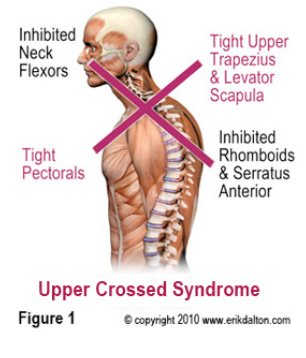Upper crossed syndrome is a term for the general pattern of postural imbalance and muscular compensation most prevalent in our society which leads to poor movement, increased joint stress, and neck or shoulder injuries. It is especially marked in people who spend a lot of time at a desk or working in a flexed forward position.
Over time, the neck flexor muscles become weak and the extensors of the back of the neck become locked in a shortened, tightened position that can be painful. The muscles on the front of the chest become tight, pulling on the shoulders and rolling them forward in a rounded position. The muscles that attach to the lower borders of the shoulder blades then become weakened and lengthened from fighting the strain pulling them forward, and may develop many tender points. The shoulder is very weak in this position, making it more prone to injury, and the load of the head on the spine feels much heavier puts much more stress on the joints.
In addition to neck and shoulder spasm and pain, upper crossed syndrome can contribute to other conditions including rotator cuff injuries, TMJ dysfunction, and headaches. This is a general pattern and everybody is different with specific muscular imbalances and mobility restrictions that need to be addressed, but people with upper crossed syndrome will feel a great improvement by consistently performing the exercises in the video above.
If you are curious about the superhero-looking fitness top I’m wearing in the video, that’s my Intelliskin PostureCue Sports Bra. Intelliskin PostureCue products when worn stimulate muscle memory and improve postural awareness to immediately improve posture and alignment and help to retrain functional movement patterns. I notice a big difference in my form when I wear mine to workout or do work around the house. Check them out below.


